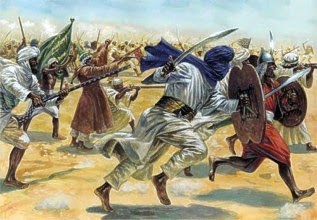Ibn Battuta's Rihla a journey around the muslim world
source = wikipedia and various piddle sources
Early life and Career:
Abu Abdullah Muhammad Ibn Battuta, was born in Tangier, Morocco, on the 24th of February 1304 C.E. (703 Hijra) during the time of the Marinid dynasty. He was commonly known as Shams ad-Din. His family was of Berber origin and had a tradition of service as judges. After receiving an education in Islamic law, he chose to travel. He left is house in June 1325, when he was twenty one years of age and set off from his hometown on a hajj (pilgrimage) to Mecca, a journey that took him 16 months. He did not come back to Morocco for at least 24 years after that. His journey was mostly by land. To reduce the risk of being attacked, he usually chose to join a caravan. In the town of Sfax, he got married. He survived wars, shipwrecks, and rebellions.
He first began his voyage by exploring the lands of the Middle East. Thereafter he sailed down the Red Sea to Mecca. He crossed the huge Arabian Desert and traveled to Iraq and Iran. In 1330, he set of again, down the Red Sea to Aden and then to Tanzania. Then in 1332, Ibn Battuta decided to go to India. He was greeted open heartedly by the Sultan of Delhi. There he was given the job of a judge. He stayed in India for a period of 8 years and then left for China. Ibn Battuta left for another adventure in 1352. He then went south, crossed the Sahara desert, and visited the African kingdom of Mali.
Death:
After the completion of the Rihla in 1355, little is known about Ibn Battuta’s life. He was appointed a judge in Morocco and died in 1368. Nevertheless, the Rihla provides an important account of many areas of the world in the 14th century.
RIHLA (the journey)
Q.2 (a). Ibn-e-batoota’s famous book rihalhah is an important source of history and geography. Justify it (5) taken from CSS 2015 EDS paper
After returning home from his travels in 1354, and at the instigation of the Marinid ruler of Morocco, Abu Inan Faris, Ibn Battuta dictated an account of his journeys to Ibn Juzayy, a scholar whom he had previously met in Granada. The account is the only source for Ibn Battuta's adventures.
The full title of the manuscript تحفة النظار في غرائب الأمصار وعجائب الأسفار may be translated as A Gift to Those Who Contemplate the Wonders of Cities and the Marvels of Travelling. However, it is often simply referred to as the Rihla الرحلة, or "The Journey".
There is no indication that Ibn Battuta made any notes during his twenty-nine years of travelling. When he came to dictate an account of his experiences he had to rely on memory and manuscripts produced by earlier travellers. Ibn Juzayy did not acknowledge his sources and presented some of the earlier descriptions as Ibn Battuta's own observations. When describing Damascus, Mecca, Medina and some other places in the Middle East, he clearly copied passages from the account by the Andalusian Ibn Jubayr which had been written more than 150 years earlier. Similarly, most of Ibn Juzayy's descriptions of places in Palestine were copied from an account by the 13th-century traveller Muhammad al-Abdari.
Scholars do not believe that Ibn Battuta visited all the places he described and argue that in order to provide a comprehensive description of places in the Muslim world, he relied on hearsay evidence and made use of accounts by earlier travellers. For example, it is considered very unlikely that Ibn Battuta made a trip up the Volga River from New Sarai to visit Bolghar and there are serious doubts about a number of other journeys such as his trip to Sana'a in Yemen, his journey from Balkh to Bistam in Khorasan and his trip around Anatolia. Some scholars have also questioned whether he really visited China.However, even if the Rihla is not fully based on what its author personally witnessed, it provides an important account of much of the 14th-century world.
Ibn Battuta often experienced culture shock in regions he visited where the local customs of recently converted peoples did not fit in with his orthodox Muslim background. Among the Turks and Mongols, he was astonished at the freedom and respect enjoyed by women and remarked that on seeing a Turkish couple in a bazaar one might assume that the man was the woman's servant when he was in fact her husband. He also felt that dress customs in the Maldives, and some sub-Saharan regions in Africa were too revealing. He particularly made note of cannibalism (The practice of eating the flesh of your own kind) practiced in West Africa:
Sultan Mansa Suleiman was visited by a party of these negro cannibals... and gave them as his hospitality-gift a servant, a negress. They killed and ate her, and having smeared their faces and hands with her blood came to the sultan to thank him... Someone told me about them that they say that the choicest parts of women’s flesh are the palm of the hand and the breast...” —Ibn Battuta, Rihla of Ibn Battuta
Little is known about Ibn Battuta's life after completion of his Rihla in 1355. He was appointed a judge in Morocco and died in 1368 or 1369.

.jpg)



.jpg)




CAN WE GET TOTAL MARKS BY WRITING THIS ANS?
ReplyDelete